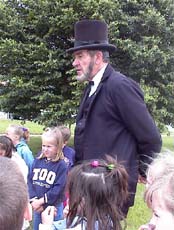|
On
Tuesday Lincoln was full of first-graders. In the morning, classes
came by bus from Congerville and Goodfield to learn about Lincoln
the town, Lincoln the man, and what goes on in a courthouse. After
their tour, these children climbed on the northbound Amtrak for a
ride on the train to Bloomington. Usherwood and her assistant,
Heidi Browne, barely had time to say goodbye to that group before
meeting the southbound train and 83 first-graders from St. Clare’s
School in Bloomington.
"It’s
going to be like this all week," Usherwood said. To help
handle the crowds, she calls upon local historian Paul Gleason and
Lincoln impersonator Charles Ott.

[Charles Ott, Abraham Lincoln impersonator,
talks to children on a field trip to Lincoln.]
At
the State Bank of Lincoln facility at Broadway and Sangamon, the
first-graders measured their hands and feet against Lincoln’s,
many asking what size shoes he wore (probably a 15). They saw the
Lloyd Ostendorf paintings and learned that Lincoln the boy didn’t
have paper so he had to scratch out his math problems on the
fireplace shovel. They also learned that, because there were no
motels, Lincoln and other circuit riders stayed the night in
farmhouses, where they were welcomed because they brought news and
conversation.

[Drew Schrock of Congerville measures his
hands and feet against casts of Abraham Lincoln's
huge hands and size-15 feet.]
In
photographs and life masks they saw how much Lincoln aged after he
became president. "It was a stressful time for him,"
Usherwood said. "He worried about a lot of things, especially
about the boys getting killed in the Civil War."
At
the watermelon statue at the depot, Lincoln impersonator Charles
Ott, with beard, top hat and long black coat, explained how
Lincoln the man christened Lincoln the town with the juice of a
watermelon squeezed into a tin cup.
"There
are 27 other towns named Lincoln in the United States, but this is
the only one named for him before he became president," Ott
told the group.
At
the courthouse, the children saw a statue of Lincoln without a
beard and learned why he grew it.
"A
little girl wrote to him and said, ‘My brother looks good with
chin-whiskers, and I think you would, too.’" Usherwood told
them. "So he grew some. When you see a picture of him with a
beard, you know he was president then."
(To top of second
column)
|

At
the courthouse they were told that the 1905 building was
deliberately constructed above street level so people would have
to look up. "They wanted to show people that they should look
up to their government," Usherwood told them.

[First-graders from
Congerville study the mosaic tile seal on the floor of the Logan
County Courthouse.]
Sitting
in a courtroom on the third floor impressed most of the
first-graders. They learned that people take their hats off as a
sign of respect. They also learned that the wire racks under the
chairs had been put there so men wearing hats could put them
safely under the chairs.
The
first-graders were intrigued by seeing prisoners in striped suits
in the courthouse and wanted to know what they had done to get
into trouble. They also learned that the authentic Civil War
cannon on the grounds is worth at least $10,000, because that was
the price a collector offered for it. The county board refused to
sell it.

The
telephone booth on the top of City Hall was another highlight. The
children were told that at one time tornado spotters used to sit
up there and watch for twisters. If they spotted one, they would
push a button and a siren would sound.

Although
Lincoln area students also take the tour, 90 percent of the
children who come are from other places, most more than 30 miles
away. Many of them are repeats. Usherwood’s tours become more
sophisticated for older students and adults. "I can give a
tour that lasts one hour or one that takes four hours," she
said.
[Joan
Crabb]
|
|
Ken
Ebelherr, fire chief, said that the training is ongoing and routine
programs are provided by department employees for others on the
Lincoln squad.
"The
facilities in the garage are also utilized by other fire personnel
that work at fire stations in other Logan County towns," he said.

The
department also uses a number of videotapes and related written
material. A hazardous materials class is conducted yearly to refresh
techniques. Updates related to the dealing with hazardous spills are
done routinely.
Ebelherr
said that one current project is training employees to use a computer
system that is tied into the University of Illinois's fire training
database.

"We
are going to utilize the computer lab at Heartland College so that
more employees can be trained in these programs," he added.
"The
training conducted in the city garage is twofold," according to
Don Fulk, assistant chief on C-shift.
"The
portion that contains the partial structure is used to train the men
on how to extricate other firefighters from a burning structure,
should that become necessary.

"The
interior of the building is blanketed with smoke from a smoke machine
in order to duplicate conditions that would be present," he
added.
The
other side of the garage also duplicates rooms that may be found in
residences. The rooms are periodically rearranged so that the
conditions vary each time a session is conducted.

Fulk
said that mannequins also are used to place in various parts of the
house in order to typify a residential fire.
(To top of second
column)
|

The
training not only keeps the firefighters current and prepared,
Ebelherr said, but it also helps with the rating the city receives
from the Insurance Service Organization.
"Various
factors that relate to a fire department's ability to respond to a
fire, such as water supply, number of personnel, communications with
the 911 system and training programs, all are graded to determine each
particular fire department's probability to effectively fight a
fire," he said.
Lincoln's
rating is one of the highest that can be attained.
Ebelherr
said that another program that will become more visible is called the
704 program.
"The
project places colored symbols on the outside of businesses that
contain flammable or toxic chemicals," he said. "If a fire
should occur, firefighters would know when they arrived what type of
fire they would have to fight, according to the rating symbol placed
at the business," Ebelherr added.

Not
only is mental agility required in order to fight fires, but physical
ability is necessary in order to tolerate the demands of such a
profession. Tucked away in a small room in the basement of city hall
are various pieces of exercise equipment that are at the disposal of
the employees.
The
21 men on the three shifts, plus the chief, comprise the city's
department. Although training is routine, each fire can be different.
Fire inspections are made in various businesses, places of employment
and public places.

"The
purpose of these inspections," according to Ebelherr, "is
twofold. One, we want to help prevent situations that could create
fires, and secondly, it keeps our personnel current on any changes
that have been made that could affect the department's response to a
fire," he said.
Training,
whether it is within the department or other departments or in the
community with the "Safe House," provides not only the
citizens of Lincoln but those in Logan County as well, with personnel
ready to respond and a system that complies with the most up-to-date
techniques.
[Fuzz
Werth]
|



